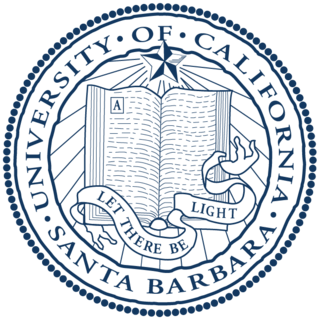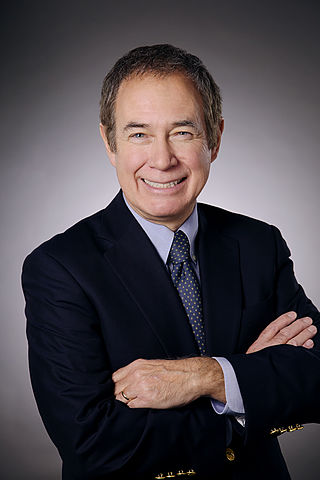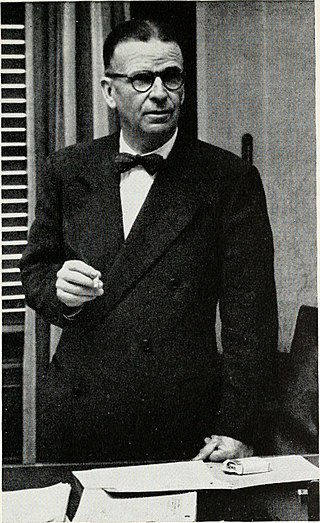Related Research Articles

Bell Labs is an American industrial research and development (R&D) company credited with the development of radio astronomy,the transistor,the laser,the photovoltaic cell,the charge-coupled device (CCD),information theory,the Unix operating system,and the programming languages B,C,C++,S,SNOBOL,AWK,AMPL,and others. Ten Nobel Prizes and five Turing Awards have been awarded for work completed at Bell Laboratories.

Claude Elwood Shannon was an American mathematician,electrical engineer,computer scientist and cryptographer known as the "father of information theory" and as the "father of the Information Age". Shannon was the first to describe the Boolean gates that are essential to all digital electronic circuits,and was one of the founding fathers of artificial intelligence. He is credited alongside George Boole for laying the foundations of the Information Age.

The University of California,Santa Barbara is a public land-grant research university in Santa Barbara County,California,United States. Tracing its roots back to 1891 as an independent teachers' college,UCSB joined the University of California system in 1944. It is the third-oldest undergraduate campus in the system,after UC Berkeley and UCLA.

Herbert Kroemer was a German-American physicist who,along with Zhores Alferov,received the Nobel Prize in Physics in 2000 for "developing semiconductor heterostructures used in high-speed- and opto-electronics". Kroemer was professor emeritus of electrical and computer engineering at the University of California,Santa Barbara,having received his Ph.D. in theoretical physics in 1952 from the University of Göttingen,Germany,with a dissertation on hot electron effects in the then-new transistor. His research into transistors was a stepping stone to the later development of mobile phone technologies.
Arthur C. Gossard was a professor of materials and electrical engineering at the University of California,Santa Barbara. In 1982,he co-discovered the fractional quantum Hall effect. His research is related to molecular beam epitaxy (MBE). He has a doctorate in physics from UC Berkeley. After university,he joined Bell Labs.
The Kavli Foundation,based in Los Angeles,California,is a foundation that supports the advancement of science and the increase of public understanding and support for scientists and their work.
The IEEE Eric E. Sumner Award is a Technical Field Award of the IEEE. It was established by the IEEE board of directors in 1995. It may be presented annually,to an individual or a team of not more than three people,for outstanding contributions to communications technology. It is named in honor of Eric E. Sumner,1991 IEEE President.
Rod C. Alferness was president of The Optical Society in 2008.

Anthony Michael Johnson is an American experimental physicist,a professor of physics,and a professor of computer science and electrical engineering at the University of Maryland,Baltimore County (UMBC). He is the director of the Center for Advanced Studies in Photonics Research (CASPR),also situated on campus at UMBC. Since his election to the 2002 term as president of the Optical Society,formerly the Optical Society of America,Johnson has the distinction of being the first and only African-American president to date. Johnson's research interests include the ultrafast photophysics and nonlinear optical properties of bulk,nanostructured,and quantum well semiconductor structures,ultrashort pulse propagation in fibers and high-speed lightwave systems. His research has helped to better understand processes that occur in ultrafast time frames of 1 quadrillionth of a second. Ultrashort pulses of light have been used to address technical and logistical challenges in medicine,telecommunications,homeland security,and have many other applications that enhance contemporary life.

Richard H. Frenkiel is an American engineer,known for his significant role in the early development of cellular telephone networks.
The Physics Department at the University of California,Santa Barbara has 58 faculty members. It offers academic programs leading to the B.A.,B.S.,and Ph.D. degrees.

Mohamed M. Atalla was an Egyptian-American engineer,physicist,cryptographer,inventor and entrepreneur. He was a semiconductor pioneer who made important contributions to modern electronics. He is best known for inventing,along with his colleague Dawon Kahng,the MOSFET in 1959,which along with Atalla's earlier surface passivation processes,had a significant impact on the development of the electronics industry. He is also known as the founder of the data security company Atalla Corporation,founded in 1972. He received the Stuart Ballantine Medal and was inducted into the National Inventors Hall of Fame for his important contributions to semiconductor technology as well as data security.

Paul R. Prucnal is an American electrical engineer. He is a professor of electrical engineering at Princeton University. He is best known for his seminal work in Neuromorphic Photonics,optical code division multiple access (OCDMA) and the invention of the terahertz optical asymmetric demultiplexor (TOAD). He is currently a fellow of IEEE for contributions to photonic switching and fiber-optic networks,Optical Society of America and National Academy of Inventors.
Donald J. Leonard is an American electrical engineer and AT&T executive,who received the 1996 IEEE Simon Ramo Medal.

Mervin Joseph Kelly was an American industrial physicist. He worked at Bell Labs from 1925 to 1959,in which time he held positions such as director of research,president,and chairman of the board of directors.
An Auston switch is an optically gated antenna that is commonly used in the generation and detection of pulsed terahertz radiation. It is named after the physicist David H. Auston who first developed the technology at Bell Labs in the 1960s.
Morris Tanenbaum was an American physical chemist and executive who worked at Bell Laboratories and AT&T Corporation.

Mona Jarrahi is an Iranian Engineering professor at the University of California,Los Angeles. She investigates novel materials,terahertz/millimeter-wave electronics and optoelectronics,microwave photonics,imaging and spectroscopy systems.

John E. Bowers is an American physicist,engineer,researcher and educator. He holds the Fred Kavli Chair in Nanotechnology,the director of the Institute for Energy Efficiency and a distinguished professor in the Departments of Electrical and Computer Engineering and Materials at University of California,Santa Barbara. He was the deputy director of American Institute of Manufacturing of Integrated Photonics from 2015 to 2022.
References
- ↑ Siegel, Peter H. (September 2011). "Terahertz Pioneer: David H. Auston" (PDF). IEEE Transactions on Terahertz Science and Technology. 1 (1): 6–8. Bibcode:2011ITTST...1....6S. doi:10.1109/TTHZ.2011.2151130. S2CID 42732371. Archived from the original (PDF) on 4 November 2014. Retrieved 4 November 2014.
- ↑ "University Archives - Our Presidents". Case Western Reserve University. Retrieved 4 November 2014.
- ↑ Rairden, Tony (November 5, 2009). "David H. Auston Appointed to UCSB Energy Frontier Research Center Post". UCSB College of Engineering. Retrieved 4 November 2014.